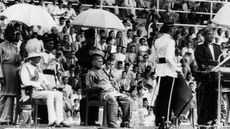28 January 1958: the Lego brick is patented
Godtfred Kirk Christiansen, the son of the Danish founder of Lego, patents the famous eight-stud Lego brick, on this day in 1958.

When you consider how phenomenally successful the simple eight-stud Lego brick has been since it first went on sale in Denmark in 1949, it's amazing to think it took Godtfred Kirk Christiansen, whose father founded Lego, nine years to patent it. But it was only at lunchtime on 28 January 1958, at two minutes to two, that the Dane filed his patent.
The clever bit behind the "automatic binding brick" were the tiny tubes inside. They gave each eight-stud brick, known as a 2x4, better grip when placed on top of each other. That not only made structures stronger, but it also made it easy for a child to pull them apart again. They have been made to the same measurements ever since.
According to Lego (the name comes from the Danish leg godt, meaning "play well"), you would need 40 billion bricks to reach the moon. So it's just as well that in 2012, Lego made 45.7 billion bricks at a rate of 5.2 million per hour. But if just stacking them sounds a bit boring, six eight-stud Lego bricks can be combined in 915,103,765 different ways.
Subscribe to MoneyWeek
Subscribe to MoneyWeek today and get your first six magazine issues absolutely FREE

Sign up to Money Morning
Don't miss the latest investment and personal finances news, market analysis, plus money-saving tips with our free twice-daily newsletter
Don't miss the latest investment and personal finances news, market analysis, plus money-saving tips with our free twice-daily newsletter
Lego entered a rough patch from 1998 when the company posted its first ever loss. But since then, it has proved to be the king of turnarounds, thanks to film tie-ins with Star Wars, for example, and computer games. In the first half of 2015, Lego enjoyed sales growth of 18%. Forbes rates the brand as being worth $6.2bn.
Chris Carter spent three glorious years reading English literature on the beautiful Welsh coast at Aberystwyth University. Graduating in 2005, he left for the University of York to specialise in Renaissance literature for his MA, before returning to his native Twickenham, in southwest London. He joined a Richmond-based recruitment company, where he worked with several clients, including the Queen’s bank, Coutts, as well as the super luxury, Dorchester-owned Coworth Park country house hotel, near Ascot in Berkshire.
Then, in 2011, Chris joined MoneyWeek. Initially working as part of the website production team, Chris soon rose to the lofty heights of wealth editor, overseeing MoneyWeek’s Spending It lifestyle section. Chris travels the globe in pursuit of his work, soaking up the local culture and sampling the very finest in cuisine, hotels and resorts for the magazine’s discerning readership. He also enjoys writing his fortnightly page on collectables, delving into the fascinating world of auctions and art, classic cars, coins, watches, wine and whisky investing.
You can follow Chris on Instagram.
-
 Barclays warns of significant rise in social media investment scams
Barclays warns of significant rise in social media investment scamsInvestment scam victims are losing an average £14k, with 61% of those falling for one over social media. Here's how to spot one and keep your money safe
By Oojal Dhanjal Published
-
 Over a thousand savings accounts now offer inflation-busting rates – how long will they stick around?
Over a thousand savings accounts now offer inflation-busting rates – how long will they stick around?The rate of UK inflation slowed again in March, boosting the opportunity for savers to earn real returns on cash in the bank. But you will need to act fast to secure the best deals.
By Katie Williams Published
-
 31 August 1957: the Federation of Malaya declares independence from the UK
31 August 1957: the Federation of Malaya declares independence from the UKFeatures On this day in 1957, after ten years of preparation, the Federation of Malaya became an independent nation.
By Jasper Spires Published
-
13 April 1960: the first satellite navigation system is launched
Features On this day in 1960, Nasa sent the Transit 1B satellite into orbit to provide positioning for the US Navy’s fleet of Polaris ballistic missile submarines.
By Ben Judge Published
-
9 April 1838: National Gallery opens in Trafalgar Square
Features On this day in 1838, William Wilkins’ new National Gallery building in Trafalgar Square opened to the public.
By Ben Judge Published
-
3 March 1962: British Antarctic Territory is created
Features On this day in 1962, Britain formed the British Antarctic Territory administered from the Falkland Islands.
By Chris Carter Published
-
10 March 2000: the dotcom bubble peaks
Features Tech mania fanned by the dawning of the internet age inflated the dotcom bubble to maximum extent, on this day in 2000.
By Chris Carter Last updated
-
9 March 1776: Adam Smith publishes 'The Wealth of Nations'
Features On this day in 1776, Adam Smith, the “father of modern economics”, published his hugely influential book The Wealth of Nations.
By Ben Judge Last updated
-
8 March 1817: the New York Stock Exchange is formed
Features On this day in 1817, a group of brokers moved out of a New York coffee house to form what would become the biggest stock exchange in the world.
By Chris Carter Last updated
-
7 March 1969: Queen Elizabeth II officially opens the Victoria Line
Features On this day in 1969, Queen Elizabeth II took only her second trip on the tube to officially open the underground’s newest line – the Victoria Line.
By Ben Judge Last updated